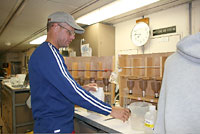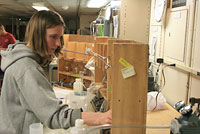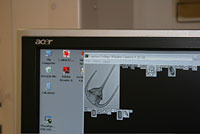

 | |||||||||||||||
|
|
Journals 2008/2009Jeff Lawrence
December 7, 2008 In the lab, lab technician Emily Lyczkowski and I prepared samples by adding filters to the main filtering station. At this station we filter for CHN, organic carbon, inorganic carbon, nitrogen, and just carbon also. We also conduct cell counts at 50 milliliters and prepare them for storage, later the team will look at them under a microscope back at Bigelow Labs in Boothbay Harbor, Maine. There is also a measurement taken for chlorophyll A, which is used by phytoplankton in the process of photosynthesis. The amount of photosynthesizing happening in any given spot of the ocean will tell the scientist more about how productive that spot is for organics that live in the water. There are several other parameters being measured from the water sample. Who knew that there was so much in each drop of water?
A Ceratium shows up on the flow cam. Ceratiums can be small to large in microscopic terms large would be as big as 1 mm. This particular Ceratium found just off the coast of Argentina on the 3rd full day at sea measures almost 200 microns across. The FlowCam is able to take samples of ocean water and force into a small tube. The microscopic organisms in the FlowCam can all be viewed on a computer monitor. Also inside the flow cam as a laser passes through each sample. Each sample is counted by the flow cam, sized, and imaged. It saves many man-hours of lab people not having to identify these microscopic organisms on slides back at their laboratory. Look at the image below, it shows one of the many microscopic organisms found in a 50 mL volume of ocean water.
Questions of the Day:
|
||||||||||||||


